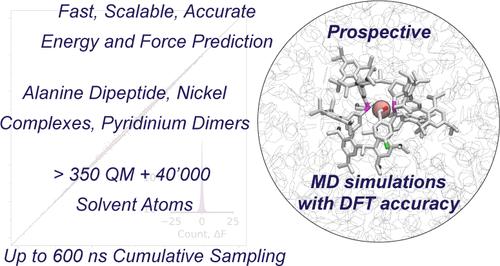Neural Network Potential with Multiresolution Approach Enables Accurate Prediction of Reaction Free Energies in Solution
IF 14.4
1区 化学
Q1 CHEMISTRY, MULTIDISCIPLINARY
引用次数: 0
Abstract
We present the design and implementation of a novel neural network potential (NNP) and its combination with an electrostatic embedding scheme, commonly used within the context of hybrid quantum-mechanical/molecular-mechanical (QM/MM) simulations. Substitution of a computationally expensive QM Hamiltonian by an NNP with the same accuracy largely reduces the computational cost and enables efficient sampling in prospective MD simulations, the main limitation faced by traditional QM/MM setups. The model relies on the recently introduced anisotropic message passing (AMP) formalism to compute atomic interactions and encode symmetries found in QM systems. AMP is shown to be highly efficient in terms of both data and computational costs and can be readily scaled to sample systems involving more than 350 solute and 40,000 solvent atoms for hundreds of nanoseconds using umbrella sampling. Most deviations of AMP predictions from the underlying DFT ground truth lie within chemical accuracy (4.184 kJ mol–1). The performance and broad applicability of our approach are showcased by calculating the free-energy surface of alanine dipeptide, the preferred ligation states of nickel phosphine complexes, and dissociation free energies of charged pyridine and quinoline dimers. Results with this ML/MM approach show excellent agreement with experimental data and reach chemical accuracy in most cases. In contrast, free energies calculated with static DFT calculations paired with implicit solvent models or QM/MM MD simulations using cheaper semiempirical methods show up to ten times higher deviation from the experimental ground truth and sometimes even fail to reproduce qualitative trends.

求助全文
约1分钟内获得全文
求助全文
来源期刊
CiteScore
24.40
自引率
6.00%
发文量
2398
审稿时长
1.6 months
期刊介绍:
The flagship journal of the American Chemical Society, known as the Journal of the American Chemical Society (JACS), has been a prestigious publication since its establishment in 1879. It holds a preeminent position in the field of chemistry and related interdisciplinary sciences. JACS is committed to disseminating cutting-edge research papers, covering a wide range of topics, and encompasses approximately 19,000 pages of Articles, Communications, and Perspectives annually. With a weekly publication frequency, JACS plays a vital role in advancing the field of chemistry by providing essential research.

 求助内容:
求助内容: 应助结果提醒方式:
应助结果提醒方式:


